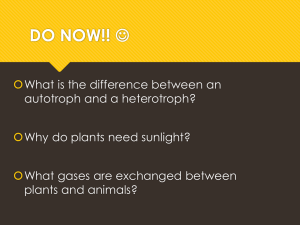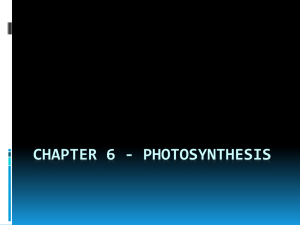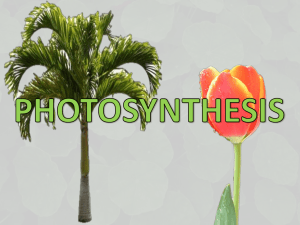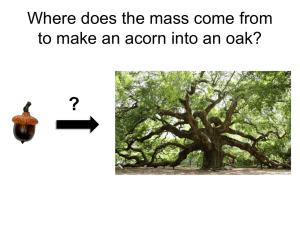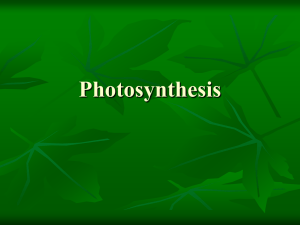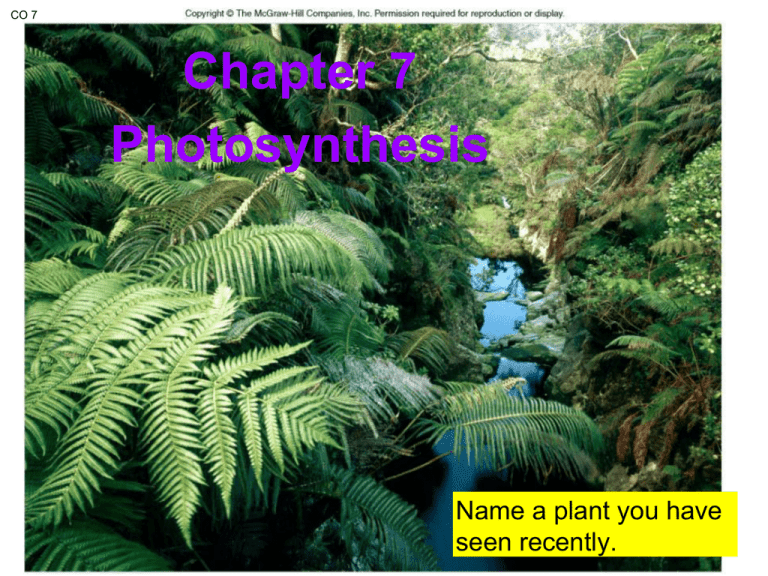
CO 7
Chapter 7
Photosynthesis
Name a plant you have
seen recently.
Nutrition Patterns
Autotrophs (producers)
Photosynthesis:plants, algae and some
prokaryotes
Chemosynthesis - rare - some bacteria
obtains organic food without
eating other organisms
Heterotrophs
(consumers/decomposers)
-obtains organic food by eating other organisms or their
by-products
Oxidation: partial or
complete loss of electrons
-exergonic (release
energy)
Reduction: partial or
complete gain of
electrons -endergonic
(absorb energy)
A. Photosynthetic Reaction
1. In 1930 C. B. van Niel showed that O2 given off by
photosynthesis comes from water and not from CO2.
2. The net equation reads:
6H2O + 6CO2
Carbon
Water + dioxide
light
C6H12O6 + 6O2
Glucose +
in the chloroplast
oxygen
How are they connected?
Heterotrophs
making energy & organic molecules from ingesting organic molecules
glucose + oxygen carbon + water + energy
dioxide
C6H12O6 +
6O2
6CO2 + 6H2O + ATP
oxidation = exergonic
Autotrophs
making energy & organic molecules from light energy
Where’s
the ATP?
carbon + water + energy glucose + oxygen
dioxide
6CO2 + 6H2O +light
energy
reduction = endergonic
C6H12O6
+ 6O2
Photosynthetic Organisms
2. Photosynthesis
transforms solar energy
into chemical energy
Organic molecules
(carbs!) built by
photosynthesis provide
both the building blocks
and energy for cells.
Figure 7.1b
3. Plants use the raw materials:
carbon dioxide and water
4. Chloroplasts carry out
photosynthesis
- Stoma: opening in
the leaf to exchange
gas
aka: stomata
Figure 7.1c
Chlorophylls
and other
pigments
involved in
absorption of
solar energy
reside within
thylakoid
membranes
of
chloroplasts
4. The chloroplast
Stomata: opening in leaf for gas exchange
Pigment: chlorophyll
Mesophyll: Plant cell photosynthetic layer:
Sites of photosynthesis (Double membrane)
granum (stack)
Thylakoids (pancake) contains:
• chlorophyll molecules
• electron transport chain
• ATP synthase
- Location of light reaction
Stroma-fluid-filled interior
(syrup)
- Location of dark reaction
Quick Check - FIVE OR FEWER
1. Chloroplast
2. Thylakoid
3. Photosynthesis
4. Organic Molecules involved
Two words that sound
alike but are not at all
similar:
Stroma: liquid in
chloroplast
Stoma: pore in
leaves
7.2 Plants as Solar Energy Converters
Solar Radiation - Only 42% of solar radiation that hits the
earth’s atmosphere reaches surface; most is visible light.
Sunlight has all
the colors
Objects only
reflect some
colors
A. Photosynthetic Pigments - Pigments found in
chlorophyll absorb various portions of visible light;
absorption spectrum.
1. Two major photosynthetic pigments are chlorophyll a and
chlorophyll b.
2. Both chlorophylls absorb violet, blue, and red wavelengths best.
- Most green is reflected back; this is why leaves appear green.
3. Carotenoids are
yellow-orange
pigments which
absorb light in violet,
blue, and green
regions.
4. When chlorophyll
breaks down in fall,
the yellow-orange
pigments in leaves
show through.
Chromatography
- Separation of
pigments based on
their size and
solubility
B. Absorption and
action spectrum - A
spectrophotometer
measures the amount
of light that passes
through a sample of
pigments.
1) As different
wavelengths are
passed through, some
are absorbed.
2) Graph of percent of
light absorbed at each
wavelength is
absorption spectrum
.
Absorption spectrum
3) Photosynthesis produces
oxygen; production of oxygen is
used to measure the rate of
photosynthesis.
4) Oxygen production and,
therefore, photosynthetic activity
is measured for plants under
each specific wavelength;
plotted on a graph, this
produces an action spectrum.
5) Since the action spectrum
resembles absorption spectrum,
this indicates that chlorophylls
contribute to photosynthesis.
action spectrum
Checkpoint:
http://www.glencoe.com/sites/common_assets/science/virtual_labs/L
S12/LS12.html
1. What is the relationship between the absorption spectrum and the
action spectrum?
2. How can we measure the rate of photosynthesis?
3. How is the wavelength of light related to the rate of
photosynthesis?
4. A radish plant is grown
behind using lights of
different colors. Explain the
chart.
QOD:
1. write the equation for photosynthesis (from memory)
2. How can we measure the rate of photosynthesis?
3. How is the wavelength of light related to the rate of
photosynthesis?
4. A radish plant is grown
using lights of different
colors. Explain the chart.
6H2O + 6CO2
Carbon
Water + dioxide
light
C6H12O6 + 6O2
Glucose +
in the chloroplast
oxygen
Inside a Chloroplast
H2O
CO2
Light
NADP+
ADP + P
Calvin
Cycle
Calvin
cycle
Chloroplast
O2
Sugars
C6H12O6
Copyright Pearson Prentice
Hall
Lightdependent
reactions
1. Light reactions cannot take place unless light is present.
They are the energy-capturing reactions.
b. Chlorophyll within thylakoid membranes absorbs solar
energy and energizes electrons.
c. Energized electrons move down the electron transport
system; energy is captured and used for ATP production.
d. Energized electrons are also taken up by NADP+, becoming
NADPH.
2. Calvin Cycle
Reactions
a. These reactions take
place in the stroma; can
occur in either the light
or the dark.
b. These are synthesis
reactions that use
NADPH and ATP to
reduce CO2.
-- and make a
carbohydrate, sugar
What you should know by now..
1. The equation for photosynthesis. Write it!
2. The structure of a chloroplast. Sketch it!
3. The two reactions of photosynthesis.
**Things are about to get much more difficult**
The Light Reactions
1. PHOTOPHOSPHORYLATION = ATP production
also called CHEMIOSMOSIS,
- occurs on thylakoid membrane
2. Two paths operate within the thylakoid membrane
noncyclic
*straight line
and
cyclic
*in a circle
3. Both paths use ATP, but the noncyclic also produces
NADPH
1. Light hits photosystem II and excites an electron, H20
2. The primary electron acceptor passes the electron down the ETC and
generates ATP
3. Light is required for PSI, but not water, it generates NADPH
Light-Dependent Reactions
Inside
thyloakoid
Thylakoid
membrane
Stroma
Copyright Pearson Prentice Hall
Photosystems: Light harvesting units of the
thylakoid membrane
Composed mainly of protein
and pigment antenna
complexes
Antenna pigment molecules
are struck by photons
Energy is passed to reaction
centers (redox location)
Excited e- from chlorophyll
is trapped by a primary eacceptor
Something trivial....
Photosystem I and Photosystem II are
named based on when they were
discovered, PSI was established first.
Light-Dependent Reactions
1. Photosynthesis begins when pigments in photosystem II
absorb light, increasing their energy level.
Photosystem II
Copyright Pearson Prentice Hall
Light-Dependent Reactions
These high-energy electrons are passed on to the electron transport
chain.
Photosystem II
High-energy
electron
Electron
carriers
Copyright Pearson Prentice Hall
Light-Dependent Reactions
2. Enzymes on the thylakoid membrane break water
molecules into:
Photosystem II
2H2O
High-energy
electron
Electron
carriers
Copyright Pearson Prentice Hall
Light-Dependent Reactions
-hydrogen ions
-oxygen atoms
-energized electrons
Photosystem II
+
O2
2H2O
High-energy
electron
Electron
carriers
Copyright Pearson Prentice Hall
Light-Dependent Reactions
(2)The energized electrons from water replace the
high-energy electrons that chlorophyll lost to the
electron transport chain.
Photosystem II
+
O2
2H2O
High-energy
electron
Copyright Pearson Prentice Hall
Light-Dependent Reactions
(2) As plants remove electrons from water, oxygen
is left behind and is released into the air.
Photosystem II
+
O2
2H2O
High-energy
electron
Copyright Pearson Prentice Hall
Light-Dependent Reactions
(2)The hydrogen ions left behind when water is
broken apart are released inside the thylakoid
membrane.
Photosystem II
+
O2
2H2O
Pq
High-energy
electron
Pc
Cytochrome
complex
Copyright Pearson Prentice Hall
Light-Dependent Reactions
3. Energy from the electrons is used to transport
H+ ions from the stroma into the inner thylakoid
space.
Photosystem II
+
O2
2H2O
Pq
Pc
Cytochrome
Copyright Pearson Prentice Hall
complex
Cytochrome complex:
catalyzing the transfer of
electrons from
plastoquinol to
plastocyanin
Light-Dependent Reactions
3. High-energy electrons move through the
electron transport chain from photosystem II to
photosystem I.
Photosystem II
+
O2
2H2O
Pq
Cytochrome
complex
Pc
Photosystem I
Copyright Pearson Prentice Hall
Light-Dependent Reactions
4. Pigments in photosystem I use energy from
light to re-energize the electrons.
+
O2
2H2O
Cytochrome
complex
Photosystem I
Copyright Pearson Prentice Hall
Light-Dependent Reactions
5. NADP+ then picks up these high-energy
electrons, along with H+ ions, and reduces to
NADPH.
+
O2
2H2O
2 NADP+
2
Copyright Pearson Prentice Hall
2
NADPH
Light-Dependent Reactions
5. As electrons are passed from chlorophyll to
NADP+, more H+ ions are pumped across the
membrane.
+
O2
2H2O
2 NADP+
2
Copyright Pearson Prentice Hall
2
NADPH
Light-Dependent Reactions
(5) Soon, the inside of the membrane fills up with
positively charged hydrogen ions, which makes
the outside of the membrane negatively charged.
+
O2
2H2O
2 NADP+
2
Copyright Pearson Prentice Hall
2
NADPH
Light-Dependent Reactions
6. The difference in charges across the membrane
provides the energy to make ATP
+
O2
2H2O
2 NADP+
2
Copyright Pearson Prentice Hall
2
NADPH
Light-Dependent Reactions
(6) H+ ions cannot cross the membrane directly.
ATP synthase
+
O2
2H2O
2 NADP+
2
Copyright Pearson Prentice Hall
2
NADPH
Light-Dependent Reactions
(6) The cell membrane contains a protein called
ATP synthase that allows H+ ions to pass through
it
ATP synthase
+
O2
2H2O
2 NADP+
2
Copyright Pearson Prentice Hall
2
NADPH
Light-Dependent Reactions
(6) As H+ ions pass through ATP synthase, the
protein rotates.
ATP synthase
+
O2
2H2O
2 NADP+
2
Copyright Pearson Prentice Hall
2
NADPH
Light-Dependent Reactions
(6) As it rotates, ATP synthase binds ADP and a
phosphate group together to produce ATP.
ATP synthase
+
O2
2H2O
ADP
2 NADP+
2
Copyright Pearson Prentice Hall
2
NADPH
Light-Dependent Reactions
Because of this system, light-dependent electron
transport produces not only high-energy electrons
but ATP as well.
ATP synthase
+
O2
2H2O
ADP
2 NADP+
2
Copyright Pearson Prentice Hall
2
NADPH
Photosystems of photosynthesis
2 photosystems in thylakoid membrane
collections of chlorophyll molecules
Photosystem II: contains chlorophyll a
P680 = absorbs 680nm
wavelength red light
Photosystem I: contains
reaction
chlorophyll b
center
P700 = absorbs 700nm
wavelength red light
antenna
pigments
1. Light hits photosystem II and excites an electron, H20
2. The primary electron acceptor passes the electron down the ETC and
generates ATP
3. Light is required for PSI, but not water, it generates NADPH
Figure 7.5
Indicate which system
____1.
PS2
____2.
PS1
Both
____3.
Both
____4.
Both
____5.
Both
(PS1 or PS2 or BOTH)
Splits water
Produces NADPH
Has an electron transport chain
Requires light
Utilizes a primary electron acceptor
____6. Occurs in the thylakoid
PS2
____7. Requires the input of H20
Both
____8. The cyclic path
Both
____9. Uses chlorophyll
PS2
____10. Releases oxygen
PS2
____11. chlorophyll a
PS1
____12. chlorophyll b
chlorophyll a
ETC of Photosynthesis
Photosystem II
chlorophyll b
Photosystem I
ETC of Photosynthesis
sun
sun
H+
H+
H+
H+
O
H+
H+
H+
H+ H+
H+
H+
to Calvin Cycle
split H2O
ATP
ETC of Photosynthesis
sun
sun
H+
H+
H+
H+
O
H+
H+
H+
H+ H+
H+
H+
to Calvin Cycle
split H2O
ATP
Two Pathways of Light Reactions
1. Noncyclic
2. Cyclic
ATP Production --> CHEMIOSMOSIS
When H20 is split, two H+ remain
These H+ are pumped from the stroma into the thylakoid
This creates a gradient used to produce ATP from ADP
ATP is the whole point of Photosystem II and will be
used to power the Light Independent Reactions (Calvin
Cycle)
Noncyclic Photophosphorylation
• Light reactions elevate
electrons in
2 steps (PS II & PS I)
– PS II generates
energy as ATP
– PS I generates
reducing power as NADPH
ATP
Cyclic photophosphorylation
• If PS I can’t pass electron to
NADP…it cycles back to PS II
& makes more ATP, but no
NADPH
– coordinates light reactions to
Calvin cycle
– Calvin cycle uses more ATP
than NADPH
18 ATP +
12 NADPH
1 C6H12O6
ATP
Photophosphorylation
cyclic
photophosphorylation
NADP
NONcyclic
photophosphorylation
ATP
Are you still confused? This is pretty
hard to visualize, but through the magic
of technology, we can watch these
processes as animations
McGraw Hill Animation:
http://highered.mheducation.com/sites/0072437316/student_v
iew0/chapter10/animations.html#
https://www.youtube.com/watch?v=g78utcLQrJ4
Figure 7.7
https://www.youtube.com/v/mYbMPwmwx88
Chemiosmosis is difficult to visualize.
So... you get to color it!
Yay! colori
ng!
Schedule:
Thurs 10/23
Fri 10/24:
Photosynthesis Lab
Calvin Cycle
Tues 10/28:
Photosynthesis Quiz
Start Cellular respiration
Thurs: 10/30
Finish Cellular Respiration
Tues 11/ 4
Quiz Cellular Respiration
Start Genetics Unit Ch 9
Relate a plants anatomy
to it’s function of
photosynthesis.
(how do roots, stem,
leaves, stoma all help
with photosynthesis)
- Stoma:
opening in
the leave to
exchange
gas
The Calvin Cycle
Whoops! Wrong Calvin…
1950s | 1961
The Calvin Cycle
Also called
*The Light Independent Reactions
*The Dark Reactions
1. Named after Melvin Calvin, who
used a radioactive isotope of
carbon to trace the reactions.
2. Joseph Priestley
Experiment:
a. He put a dome over a candle, the
candle went out.
b. He added a plant for a few days to
the dome, the candle stayed lit for
a while
Conclusion: The plant produced a
substance required for burning.
3. Jan Ingenhousz: showed the effect
observed by Priestly occurred only
when the plant was exposed to
light
Conclusion: Light is necessary to
produce oxygen
a.
a.
b.
b.
b
The Calvin Cycle
is a series of reactions producing carbohydrates.
carbon dioxide fixation, carbon dioxide reduction, and
regeneration of RuBP.
Convert solar energy to chemical energy
ATP
energy
NADPH reducing power
Fixation of Carbon Dioxide
1. CO2 fixation is the attachment of CO2 to an
organic compound called RuBP.
2. RuBP (ribulose bisphosphate) is a fivecarbon molecule that combines with carbon
dioxide.
3. The enzyme RuBP carboxylase (RuBisCo) speeds this
reaction; this enzyme comprises 20–50% of the protein
content of chloroplasts
Calvin Cycle Animation
Mainly this is a reshuffling of
carbons using ATP and NADPH
as energy
http://www.uic.edu/classes/bios/bios100/lectures/calvin.htm
Fortunately....
AP Biology no longer requires the
memorization of every step of the Calvin
Cycle, but you should understand the
beginning and the end and what it's
purpose is.
Summary Statements:
What is the purpose of the Calvin Cycle?
Where does the cell get its energy to perform these reactions?
What are the main molecules involved in carbon fixation?
What is the final product?
Calvin cycle
C
C
C C C C C
1C
C C C C C
3. Regeneration
of RuBP
5C
ribulose bisphosphate
3 ATP
C= C= C
H H H
| | |
C– C– C
C
C
C
C
C
C
C
C
C
C
C
C
C
C
C
C
C
C
1. Carbon fixation
C C C C C C
RuBisCo
ribulose
bisphosphate
carboxylase
3 ADP
used
to make
glucose
CO2
C C C C C
RuBP
starch,
sucrose,
cellulose
& more
C
C C C C C C
6C
C C C C C C
5C
glyceraldehyde-3-P
G3P
C C C
PGA
phosphoglycerate
3C
6 NADP
C
C
C
C
C
C
6 ATP
2. Reduction
6 NADPH
3C
C
C
C
C
C
C
3C
6 ADP
C
C
C
C
C
C
H
|
H
|
H
|
Molecules of Calvin Cycle
• RuBP (ribulose bisphosphate) is a fivecarbon molecule that combines with
carbon dioxide= carbon fixation
• RuBisCo: the enzyme that fixes carbon
from the air
(most important enzyme in the world?)
• G3P: Glyceraldehyde-3-P: end product of
Calvin cycle, energy rich 3 carbon sugar
- 2 G3P combine to form 1 glucose
G3P: Glyceraldehyde-3-P: end product of
Calvin cycle, energy rich 3 carbon sugar
This is called “C3 photosynthesis” (normal)
G3P is an important intermediate
G3P glucose carbohydrates
lipids phospholipids, fats,
waxes
amino acids proteins
nucleic acids DNA, RNA
G3P can be
converted into
other things
QOD: photosynthesis
copy and fill out this table as best you can.
Process Light?
Location Reactant Product
(photosynt
hesis)
1. ETC
2. Calvin
Cycle
3. Relate a plants anatomy to it’s function of
photosynthesis.
(how do roots, stem, leaves, stoma all help with photosynthesis)
Process Light?
Location Reactant Product
(photosynt
hesis)
1. ETC
2. Calvin
Cycle
Thylakoid Light
membrane H2O
Light
dependent
rxn
Light
Independent
rxn
stroma
ATP
NADPH
CO2
ATP
NADPH
O2
Glucose
Relate a plants anatomy
to it’s function of
photosynthesis.
Roots: collect water for
light rxn
Stem: transport water,
minerals,
Leaves: collect sun light,
stoma: collect CO2)
- Stoma:
opening in
the leave to
exchange
gas
From CO2 C6H12O6
• CO2 has very little chemical energy
– fully oxidized
• C6H12O6 contains a lot of chemical energy
– highly reduced (contains energy in form of e-)
• Synthesis = endergonic process
– put in a lot of energy
• Reduction of CO2 C6H12O6 proceeds in
many small uphill steps
– each catalyzed by a specific enzyme
– using energy stored in ATP & NADPH
Photosynthesis summary
Light reactions
produced ATP
produced NADPH
consumed H2O
produced O2 as byproduct
Calvin cycle
consumed CO2
produced G3P (sugar)
regenerated ADP
regenerated NADP
ADP
NADP
Types of phosphorylation
Alternative Pathways
C3 PLANTS: use the normal Calvin Cycle exclusively to fix
carbon, the MOST Common Pathway
Adaptations: Plants in hot dry environments have a problem
with water loss, so they keep their stomata partly closed... this
results in:
CO2 deficit (Used in Calvin Cycle), and the level of O2
RISES (as Light reactions Split Water Molecules).
Some Plant Taxonomy
In order for photosynthesis to occur, plants must open tiny
pores on their leaves called STOMATA.
Opening these pores can lead to loss of water.
The problem: Calvin cycle when O2 is high
O2
RuBP
Hey Dude,
are you high
on oxygen!
It’s so
sad to see a
good enzyme,
go BAD!
5C RuBisCo
to
mitochondria
–––––––
lost as CO2
without
making ATP
2C
3C
Photorespiration: RuBisCo
fixation of O2, lose carbon to
CO2 without making ATP,
makes photosynthesis less
efficient
Figure 7.10
C4 plants and
CAM plants use
an alternate
pathway to FIX
carbon dioxide
from the air.
Reducing photorespiration
Alternative pathways: Separate carbon
fixation from Calvin cycle
C4 plants: PHYSICALLY separate carbon fixation from
Calvin cycle (corn, sugar cane)
• different cells to fix carbon vs. where
Calvin cycle occurs
• store carbon in 4C compounds
different enzyme to capture CO2 (fix carbon)
called PEP carboxylase
different leaf structure
CAM plants: separate carbon fixation from Calvin cycle
by TIME OF DAY (cactus, pineapple)
fix carbon during night
store carbon in 4C compounds
perform Calvin cycle during day
C4 vs CAM Summary
solves CO2 / O2 gas exchange vs. H2O loss challenge
Ex:
• Sugarcan
e
• Corn
• Crabgrass
C4 plants
separate 2 steps
of C fixation
anatomically in 2
different cells
Ex:
• Pineapple
• Cactus
CAM plants
separate 2 steps
of C fixation
temporally =
2 different times
night vs. day
Photophosphorylation
cyclic
photophosphorylation
NADP
NONcyclic
photophosphorylation
ATP
Quick Practice
Quick Practice
grana
thylakoid
stroma
O2
Summarize what is happening at 1, 2 ,and 3
C
C
C C C C C
1C
C C C C C
3. Regeneration
of RuBP
5C
ribulose bisphosphate
3 ATP
C= C= C
H H H
| | |
C– C– C
C
C
C
C
C
C
C
C
C
C
C
C
C
C
C
C
C
C
1. Carbon fixation
C C C C C C
RuBisCo
ribulose
bisphosphate
carboxylase
3 ADP
used
to make
glucose
CO2
C C C C C
RuBP
starch,
sucrose,
cellulose
& more
C
C C C C C C
6C
C C C C C C
5C
glyceraldehyde-3-P
G3P
C C C
PGA
phosphoglycerate
3C
6 NADP
C
C
C
C
C
C
6 ATP
2. Reduction
6 NADPH
3C
C
C
C
C
C
C
3C
6 ADP
C
C
C
C
C
C
H
|
H
|
H
|
What Factors the Affect Photosynthesis?
1. Light Quality (color/wavelength)
2. Light intensity
3. Carbon Dioxide Availability
4. Water Availability
Photosynthesis
Simulation
Waterweed
Simulator
*Using the photosynthesis simulation, design and test an
experiment to test light intensity and wavelength
Pg 129b
Light & H2O
CO2
ADP
NADP
ATP
NADPH
O2
glucose
A = photosystem II
B = photosystem I
C = H20
D = Electron Transport Chain
E = ATP Synthase
AB = ATP
AC = phospholipids
AD = light (energy)
Photosynthesis Activities
Chromatography of a spinach leaf
Light intensity and color simulation:
http://www.mhhe.com/biosci/genbio/biolink/j_explorations/ch
09expl.htm
Rate of photosynthesis LAB:
http://biologycorner.com/worksheets/AP_Lab5_photosynthe
sis.html
Elodiea observation:
http://www.biologycorner.com/worksheets/photosynthesis_vi
rtual_lab.html
Chapter 6
Standardized Test Prep
Multiple Choice
1. Which of the following is a reactant in the Calvin
cycle?
A. O2
B. CO2
C. H2O
D. C6H12O6
Chapter 6
Standardized Test Prep
Multiple Choice, continued
1. Which of the following is a reactant in the Calvin
cycle?
A. O2
B. CO2
C. H2O
D. C6H12O6
Chapter 6
Standardized Test Prep
Multiple Choice, continued
2. Which of the following statements is correct about
the carotenoid pigments?
F. Accessory pigments are not involved in
photosynthesis.
G. Accessory pigments add color to plants but do not
absorb light energy.
H. Accessory pigments absorb colors of light that
chlorophyll a cannot absorb.
J. Accessory pigments receive electrons from the
electron transport chain of photosystem I.
Chapter 6
Standardized Test Prep
Multiple Choice, continued
2. Which of the following statements is correct about
the carotenoid pigments?
F. Accessory pigments are not involved in
photosynthesis.
G. Accessory pigments add color to plants but do not
absorb light energy.
H. Accessory pigments absorb colors of light that
chlorophyll a cannot absorb.
J. Accessory pigments receive electrons from the
electron transport chain of photosystem I.
Chapter 6
Standardized Test Prep
Multiple Choice, continued
3. Oxygen is produced at what point during
photosynthesis?
A. when CO2 is fixed
B. when water is split
C. when ATP is converted into ADP
D. when 3-PGA is converted into G3P
Chapter 6
Standardized Test Prep
Multiple Choice, continued
3. Oxygen is produced at what point during
photosynthesis?
A. when CO2 is fixed
B. when water is split
C. when ATP is converted into ADP
D. when 3-PGA is converted into G3P
Chapter 6
Standardized Test Prep
Multiple Choice, continued
The diagram below shows
a portion of a chloroplast.
Use the diagram to answer
the question that follows.
4. Which of the following
correctly identifies the
structure marked X and the
activities that take place
there?
F. stroma—Calvin cycle
G. stroma—light reactions
H. thylakoid—Calvin cycle
J. thylakoid—light
reactions
Chapter 6
Standardized Test Prep
Multiple Choice, continued
The diagram below shows
a portion of a chloroplast.
Use the diagram to answer
the question that follows.
4. Which of the following
correctly identifies the
structure marked X and the
activities that take place
there?
F. stroma—Calvin cycle
G. stroma—light reactions
H. thylakoid—Calvin cycle
J. thylakoid—light
reactions
Chapter 6
Standardized Test Prep
Multiple Choice, continued
5. light reactions : ATP :: Calvin cycle :
A. H+
B. O2
C. G3P
D. H2O
Chapter 6
Standardized Test Prep
Multiple Choice, continued
5. light reactions : ATP :: Calvin cycle :
A. H+
B. O2
C. G3P
D. H2O
Chapter 6
Standardized Test Prep
Multiple Choice, continued
The diagram below shows a
step in the process of
chemiosmosis. Use the
diagram to answer the question
that follows.
6. What is the substance
identified as Y in the
image?
F. H+
G. NAD+
H. NADPH
J. ADP synthase
Chapter 6
Standardized Test Prep
Multiple Choice, continued
The diagram below shows a
step in the process of
chemiosmosis. Use the
diagram to answer the question
that follows.
6. What is the substance
identified as Y in the
image?
F. H+
G. NAD+
H. NADPH
J. ADP synthase
Chapter 6
Standardized Test Prep
Short Response
Chloroplasts are organelles with areas that conduct
different specialized activities.
Where in the chloroplast do the light reactions and
the Calvin cycle occur?
Chapter 6
Standardized Test Prep
Short Response, continued
Chloroplasts are organelles with areas that conduct
different specialized activities.
Where in the chloroplast do the light reactions and
the Calvin cycle occur?
Answer:
The light reactions of photosynthesis occur along the
thylakoid membrane. The Calvin cycle occurs in the
stroma, surrounding the thylakoids.
Chapter 6
Standardized Test Prep
Extended Response
The reactions of photosynthesis make up a
biochemical pathway.
Part A What are the reactants and products for both
the light reactions and the Calvin cycle?
Part B Explain how the biochemical pathway of
photosynthesis recycles many of its own
reactants, and identify the recycled reactants.
Chapter 6
Standardized Test Prep
Extended Response, continued
Answer:
Part A The reactants for the light reactions of
photosynthesis are sunlight, water, NADP+, and
ADP. The products are oxygen, ATP, and NADPH.
The reactants for the Calvin cycle are ATP, NADPH,
CO2, and RuBP. The products are NADP+, ADP, and
organic compounds.
Part B ADP/ATP, NADP+/NADPH, and electrons are
recycled during photosynthesis. RuBP, which reacts
with CO2 in the Calvin cycle, is regenerated at each
turn of the cycle.
Review of ETC of Photosynthesis
sun
1
e
e
Photosystem II
P680
chlorophyll a
Inhale, baby!
ETC of Photosynthesis
thylakoid
chloroplast
+H+ H+ H+
H+ H+H
+ + + +
H+H H H H
ATP
+H+ H+ H+
H+ H+H
+ + + +
H+H H H H
Plants SPLIT water!
H
H
1
O
2
e
e
O
+H
H+
O
ee-
e
e
fill the e– vacancy
Photosystem II
P680
chlorophyll a
H
H
ETC of Photosynthesis
thylakoid
chloroplast
+H+ H+ H+
+
+
H
H H + + H+H+ H+
HH
ATP
+H+ H+ H+
H+ H+H
+ + + +
H+H H H H
3
1
2
e
e
H+
ATP
4
H+
H+
H+
to Calvin Cycle
H+
H+
H+
+
+
H H
H+
energy to build
carbohydrates
Photosystem II
P680
chlorophyll a
ADP + Pi
ATP
H+
ETC of Photosynthesis
e
e
sun
5
e
Photosystem II
P680
chlorophyll a
e
Photosystem I
P700
chlorophyll b
ETC of Photosynthesis
electron carrier
6
e
e
5
sun
Photosystem II
P680
chlorophyll a
Photosystem I
P700
chlorophyll b
$$ in the bank…
reducing power!



